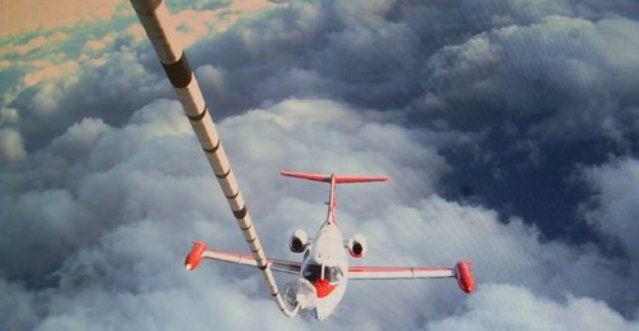
Calspan Learjet surrogate seen from the tanker operator station aboard an Omega K-707 tanker aircraft - Photo: US Navy
As part of the Unmanned Combat Air System Demonstration (UCAS-D) programme, the US Navy and industry partner Northrop Grumman have been developing Autonomous Aerial Refueling (AAR) technologies to refuel unmanned aircraft in flight.
The team completed a series of flight tests January 21 in St. Augustine, Florida, as the latest step toward demonstrating unmanned AAR capability.
“The AAR segment of the programme is intended to demonstrate a system that will enable the X-47B UCAS-D to safely approach and maneuver around tanker aircraft, performing both Navy and Air Force style refueling techniques,” said Captain Jaime Engdahl, Navy UCAS programme manager. The Navy has been working closely with the Air Force Research Lab for the past decade to develop technologies and operating concepts for AAR, Engdahl said. Both services share a common goal of enabling tankers to autonomously refuel manned and unmanned aircraft in the future, he added.
The UCAS-D team began this test phase in November when a team from Northrop Grumman installed X-47B hardware and software on a Calspan Learjet surrogate aircraft. The initial ground and taxi tests culminated in the first AAR test flight on December 20th. .The team then conducted a series of flights using the surrogate aircraft, equipped with X-47B software and hardware, and an Omega K-707 Tanker. The Learjet successfully completed multiple air-refueling test points autonomously while commanded by a ground operator.
The AAR segment of the UCAS-D programme is designed to assess the initial functionality of the X-47B AAR systems and navigation performance, as well as to test the government tanker refueling interface systems. The AAR program is using similar command and control, and navigation processes being demonstrated by the UCAS team aboard the aircraft carrier. “The next big step for the program is to demonstrate this capability with the unmanned X-47B and actually plug the aircraft autonomously,” Engdahl said. “The AAR team did an exceptional job executing flight test in St. Augustine. The team’s’ ability to successfully complete these test maneuvers so early in the program is a significant learning event and reduces risk for the future.”
The team plans to conduct two more surrogate test periods before demonstrating refueling techniques on the X-47B in 2014. Data from the tests will be used to assess system performance, demonstrate viability of the AAR concept and develop operational procedures to support further development of future unmanned systems.
“By adding an autonomous aerial refueling capability to unmanned aircraft, we can significantly increase their range, persistence and overall flexibility,” added Engdahl, who said he is very impressed with the system’s performance. “This is a game-changer for naval aviation and is critical for our success with unmanned long range aircraft in the future.”
Source: The Baynet
